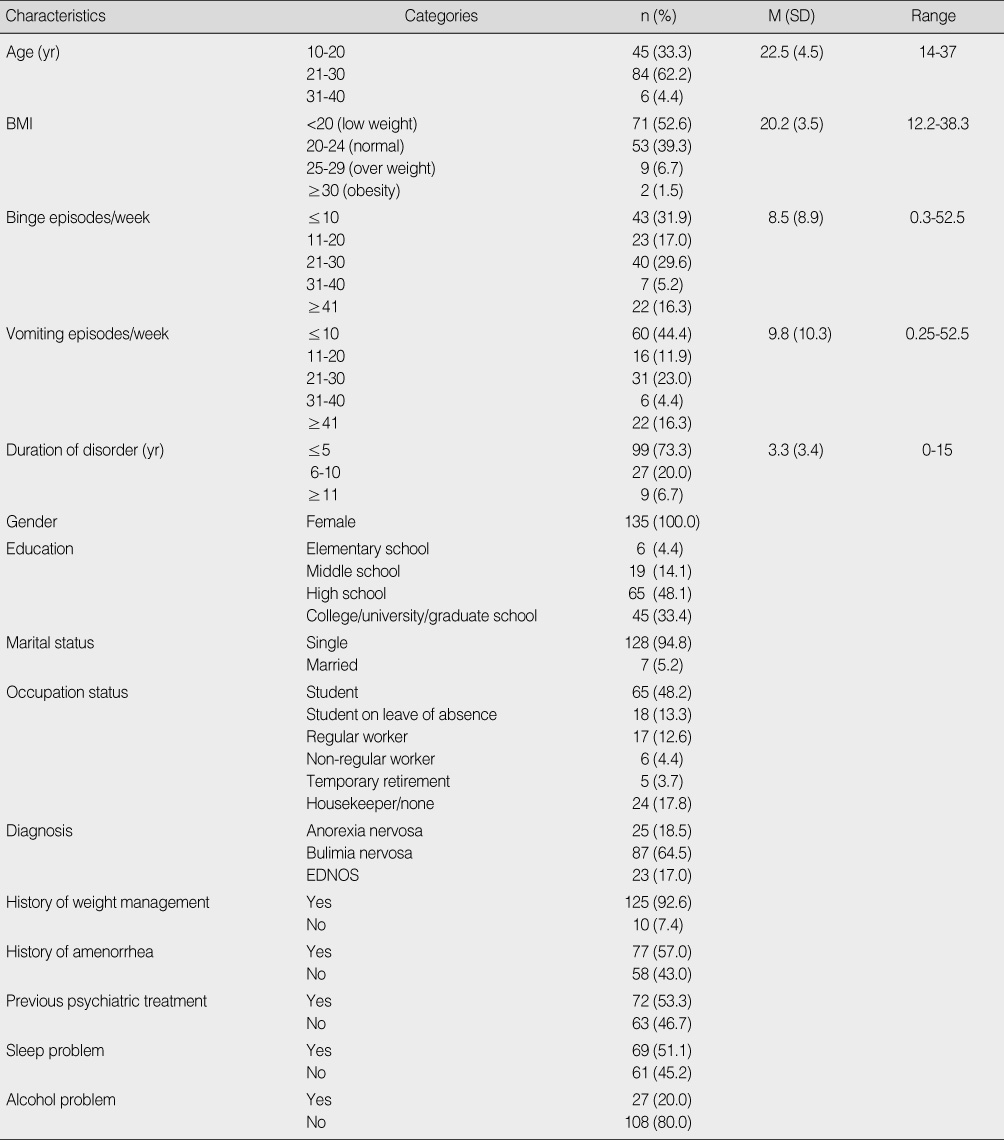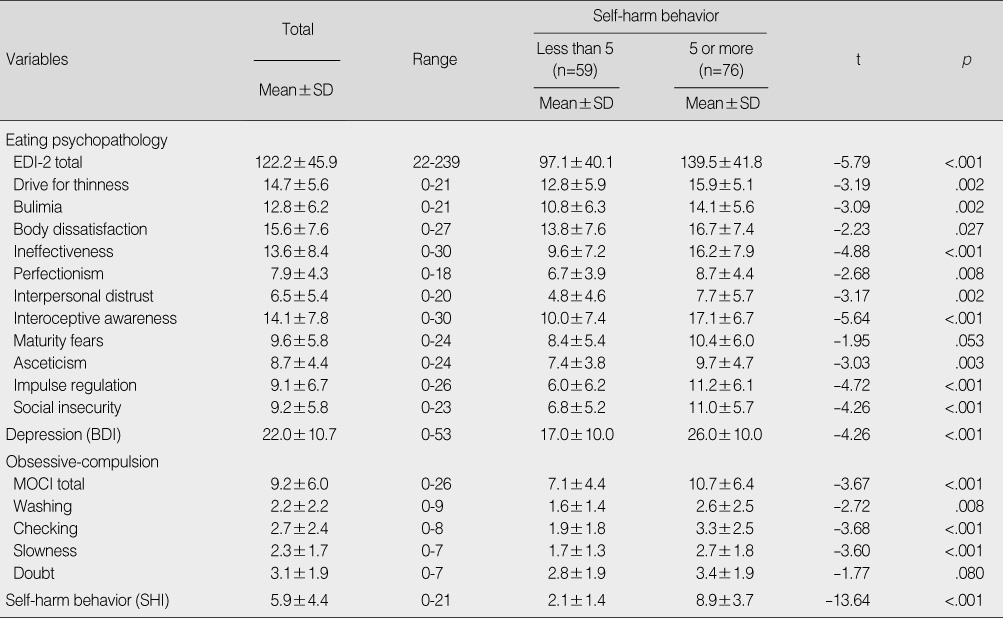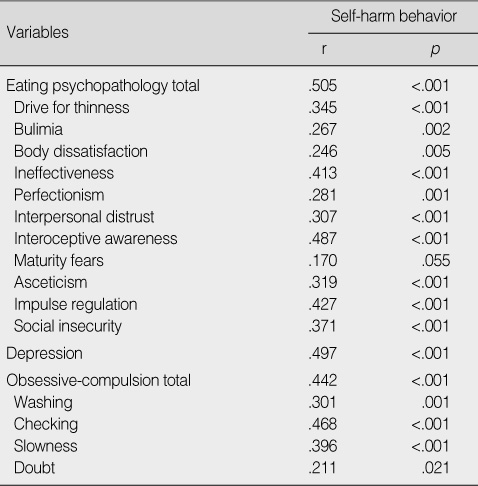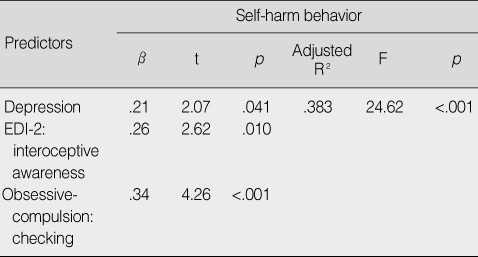Articles
- Page Path
- HOME > J Korean Acad Nurs > Volume 39(4); 2009 > Article
-
Original Article
- Impact of Eating Psychopathology, Obsessive-Compulsion and Depression on Self-Harm Behavior in Patients with Eating Disorders
- Seong Sook Kong
-
Journal of Korean Academy of Nursing 2009;39(4):459-468.
DOI: https://doi.org/10.4040/jkan.2009.39.4.459
Published online: August 31, 2009
Associate Professor, Department of Nursing, Soonchunhyang University, Cheonan, Korea.
- Address reprint requests to: Kong, Seong Sook. Department of Nursing, Soonchunhyang University, 366-1 Ssangyong-dong, Cheonan 330-090, Korea. Tel: 82-41-570-2488, Fax: 82-41-575-9347, kongsun@sch.ac.kr
Copyright © 2009 Korean Society of Nursing Science
Abstract
-
Purpose
- The purpose of the study was to investigate psychological factors such as eating psychopathology, depression, and obsessive-compulsion that might influence self-harm behavior in patients with eating disorders.
-
Methods
- Patients with eating disorders (n=135) who visited "M" clinic for eating disorders participated in the study. Data were collected from March to August 2007 using the Eating Disorder Inventory-2, Beck Depression Inventory, Maudsley Obsessional-Compulsive Inventory, and Self-Harm Inventory (SHI).
-
Results
- The participants scored high on self-harm as well as on depression and obsessive-compulsion. On the SHI, a high frequency of self harm behavior such as 'torturing self with self-defeating thoughts', 'abused alcohol', 'hit self', and 'suicide attempt' were found for the participants. There were significant correlations between most eating psychopathology variables, depression, obsessive-compulsion, and self-harm behavior. 'Interoceptive awareness' (eating psychopathology), depression, and 'checking' (obsessive-compulsion) were significant predictors of self-harm behavior.
-
Conclusion
- Future interventions for patients with eating disorders should focus on assessing the possibility of self-harm and suicidal attempts, especially in those patients with high levels of eating psychopathology, depression, or obsessive-compulsion. Early intervention for depression and obsessive-compulsion could contribute to preventing self-harm and suicide in patients with eating disorders.
- 1. American Psychiatric Association. Diagnostic and statistical manual of mental disorders. 1994;4th ed. Washington DC, American Psychiatric Association.
- 2. Anderson CB, Carter FA, McIntosh VV, Joyce PR, Bulik CM. Self-harm and suicide attempts in individuals with bulimia nervosa. Eating Disorders. 2002;10:227–243.ArticlePubMed
- 3. Beck AT, Ward CH, Mendelson M, Mock J, Erbaugh J. An inventory for measuring depression. Archives of General Psychiatry. 1961;4:561–571.ArticlePubMed
- 4. Borenstein M, Rothstein H, Cohen J. Power and precision. 1997;Mahwah, NJ, Lawrence Erlbaum.
- 5. Bulik CM, Sullivan PF, Joyce PR. Temperament, character and suicide attempts in anorexia nervosa, bulimia nervosa and major depression. Acta Psychiatrica Scandinavica. 1999;100:27–32.ArticlePubMed
- 6. Cho DK. The study of objective measurement for obsessional- compulsive behavior: The standardization of the list of obsessional-compulsive behavior in Maudsley obsessional-compulsive inventory. Seoul University Student Review. 1985;20:78–90.
- 7. Cho SJ, Jeon HJ, Kim JK, Suh TW, Kim SU, Hahm BJ, et al. Prevalence of suicide behaviors (suicidal ideation and suicide attempt) and risk factors of suicide attempts in junior and high school adolescents. Journal of Korean Neuropsychiatric Association. 2002;41:1142–1155.
- 8. Claes L, Vandereycken W, Vertommen H. Family environment of eating disordered patients with and without self-injurious behaviors. European Psychiatry. 2004;19:494–498.ArticlePubMed
- 9. Croyle KL, Waltz J. Subclinical self-harm: Range of behaviors, extent, and associated characteristics. American Journal of Orthopsychiatry. 2007;77:332–342.ArticlePubMed
- 10. Favaro A, Santonastaso P. Impulsive and compulsive self-injurious behavior in bulimia nervosa: Prevalence and psychological correlates. Journal of Nervous and Mental Disease. 1998;186:157–165.ArticlePubMed
- 11. Favaro A, Santonastaso P. Different types of self injurious behavior in bulimia nervosa. Comprehensive Psychiatry. 1999;40:57–60.ArticlePubMed
- 12. Favazza AR, Simeon D. Hollander E, Stein D. Self-mutilation. In: Impulsivity and aggression. 1995;Sussex, England, John Whey & Sons. 185–200.
- 13. Forcano L, Fernández-Aranda F, Alvarez-Moya E, Bulik C, Granero R, Gratacòs M, et al. Suicide attempts in bulimia nervosa: Personality and psychopathological correlates. European Psychiatry. 2009;24:91–97.ArticlePubMed
- 14. Franko DL, Keel PK. Suicidality in eating disorders: Occurrence, correlates, and clinical implications. Clinical Psychology Review. 2006;26:769–782.ArticlePubMed
- 15. Garner DM. Eating Disorders Inventory II. 1991;Odessa, FL, Psychological Assessment Resources.
- 16. Hahn HM, Yum TH, Shin YW, Kim KH, Yoon DJ, Chung KJ. A standardization study of Beck Depression Inventory in Korea. Journal of Korean Neuropsychiatric Association. 1986;25:487–502.
- 17. Hodgson RJ, Rachman S. Obsessional-compulsive complaints. Behaviour Research and Therapy. 1977;15:389–395.ArticlePubMed
- 18. Ko SM. Under-diagnosed psychiatric syndrome. I: Trichotillomania. Annals of the Academy of Medicine, Singapore. 1999;28:279–281.PubMed
- 19. Laquatra TA, Clopton JR. Characteristics of alexithymia and eating disorders in college women. Addictive Behaviors. 1994;19:373–380.ArticlePubMed
- 20. Lyle RM. Translation of Eating Disorders Inventory II-Korean. 1996;Odessa, FL, Psychological Assessment Resources.
- 21. Matsunaga H, Kiriike N, Iwasaki Y, Miyata A, Matsui T, Nagata T, et al. Multi-impulsivity among bulimic patients in Japan. International Journal of Eating Disorders. 2000;27:348–352.ArticlePubMed
- 22. Nagata T, Kawarada Y, Kiriike N, Iketani T. Multiimpulsivity of Japanese patients with eating disorders: Primary and Secondary Impulsivity. Psychiatry Research. 2000;94:239–250.ArticlePubMed
- 23. Paul T, Schroeter K, Dahme B, Nutzinger DO. Self-injurious behavior in women with eating disorders. American Journal of Psychiatry. 2002;159:408–411.ArticlePubMed
- 24. Roberts RE, Roberts CR, Chen YR. Suicidal thinking among adolescents with a history of attempted suicide. Journal of American Academy of Child and Adolescent Psychiatry. 1998;37:1294–1300.Article
- 25. Ruuska J, Kaltiala-Heino R, Rantanen P, Koivisto AM. Psychopathological distress predicts suicidal ideation and self-harm in adolescent eating disorder outpatients. European Child & Adolescent Psychiatry. 2005;14:276–281.ArticlePDF
- 26. Sansone RA, Levitt JL. Self-harm behaviors among those with eating disorders: An overview. Eating Disorders. 2002;10:205–213.ArticlePubMed
- 27. Sansone RA, Wiederman MW, Sansone LA. The Self-Harm Inventory (SHI): Development of a scale for identifying self-destructive behaviors and borderline personality disorder. Journal of Clinical Psychology. 1998;54:973–983.ArticlePubMed
- 28. Sullivan PF. Mortality in anorexia nervosa. American Journal of Psychiatry. 1995;152:1073–1074.ArticlePubMed
- 29. Svirko E, Hawton K. Self-injurious behavior and eating disorders: The extent and nature of the association. Suicide & Life-Threatening Behavior. 2007;37:409–421.ArticlePDF
- 30. Wildman P, Lilenfeld LR, Marcus MD. Axis I comorbidity onset and parasuicide in women with eating disorders. International Journal of Eating Disorders. 2004;35:190–197.ArticlePubMed
REFERENCES
Figure & Data
REFERENCES
Citations

- Body trust in Korean population: validation of the Korean version of the body trust scale
Yunyoung Oh, Jang-Won Seo
Frontiers in Psychiatry.2025;[Epub] CrossRef - Clinical Characteristics of Non-Suicidal Self-Injury and Suicide Attempts among Psychiatric Patients in Korea: A Retrospective Chart Review
Yubeen Bae, Yoanna Seong, Seok Hyeon Kim, Sojung Kim
Psychiatry Investigation.2020; 17(4): 320. CrossRef - Factors associated with Abnormal Eating Behaviors among Women College Students
Youjeong Choi, Suk-Sun Kim
Journal of Korean Academy of Psychiatric and Mental Health Nursing.2017; 26(2): 134. CrossRef - Body Image Dissatisfaction as a Mediator of the Association between BMI, Self-esteem and Mental Health in Early Adolescents: A Multiple-group Path Analysis across Gender
Mi Heui Jang, Gyungjoo Lee
Journal of Korean Academy of Nursing.2013; 43(2): 165. CrossRef - Factors associated with Multi-impulsivity in Women Patients with Eating Disorders
Seong Sook Kong
Journal of Korean Academy of Psychiatric and Mental Health Nursing.2012; 21(2): 137. CrossRef
Demographic and Clinical Characteristics of Participants (N=135)
BMI=body mass index; EDNOS=eating disorders not otherwise specified.
Major Variables of Participants according to Self-Harm Behavior (N=135)
EDI=Eating Disorders Inventory; BDI=Beck Depression Inventory; MOCI=Maudsley Obsessional-Compulsive Inventory.
Correlations among Self-Harm Behavior, Eating Psychopathology, Depression and Obsessive-Compulsion
Stepwise Multiple Regression of Eating Psychopathology, Depression and Obsessive-Compulsion for Self-Harm Behavior
EDI=Eating Disorders Inventory.
BMI=body mass index; EDNOS=eating disorders not otherwise specified.
EDI=Eating Disorders Inventory; BDI=Beck Depression Inventory; MOCI=Maudsley Obsessional-Compulsive Inventory.
EDI=Eating Disorders Inventory.
 KSNS
KSNS
 E-SUBMISSION
E-SUBMISSION




 Cite
Cite

